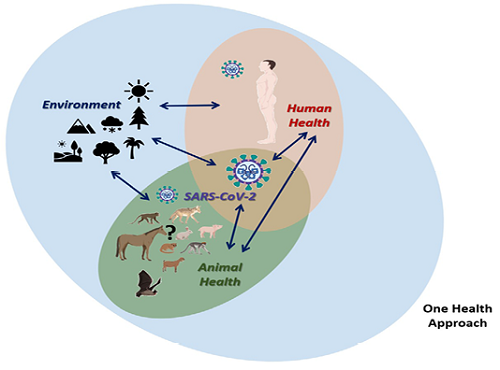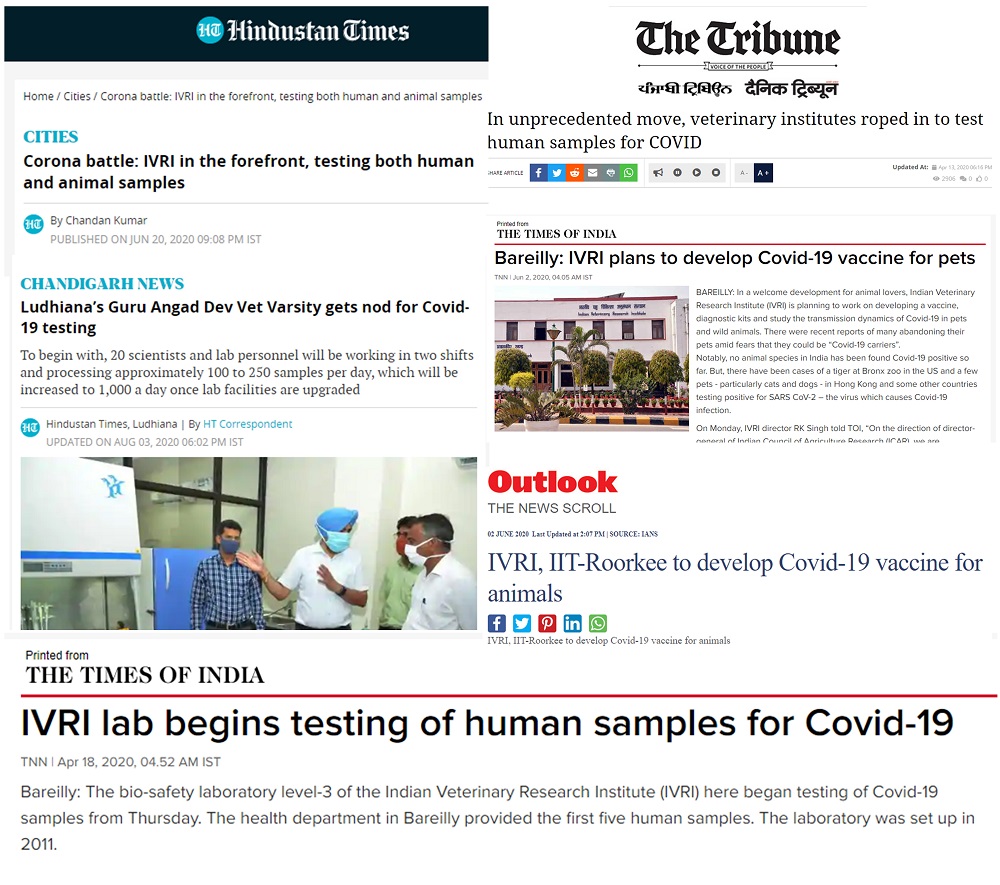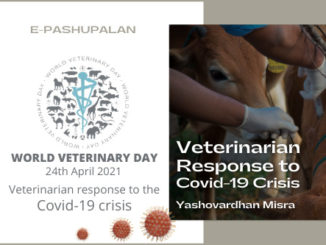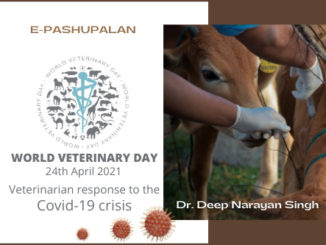Introduction
Coronavirus disease (COVID-19), caused by severe acute respiratory syndrome coronavirus 2 (SARS-CoV-2), has already infected 129.8 million people resulting in a mortality of almost 2.8 million people as of April 1, 2021 (https://www.worldometers.info/coronavirus/). COVID-19 pandemic has affected majority of the countries and has reached almost every corner of the world due to the high transmission potential (Dhama et al., 2020). SARS-CoV-2 is believed to have originated from bats similar to that of severe acute respiratory syndrome coronavirus (SARS-CoV) and Middle East respiratory syndrome coronavirus (MERS-CoV) (Malik et al., 2020). Compared to its predecessors (SARS-CoV and MERS-CoV), SARS-CoV-2 has a broad host range and superior human-to-human transmission potential that enabled them to spread rapidly around the world in a short period of time (Dhama et al., 2020; Sharun et al., 2020).

Veterinarians are considered the pioneers in animal health management throughout the globe and have significantly contributed to eradicating several zoonotic diseases over the past several decades. The contributions made by veterinarians during the COVID-19 pandemic indicate that the health of human beings, animals, and the environment are linked at a higher level suggesting the need for a transdisciplinary collaboration under the principles of One Health (Fig.1). In addition to safeguarding animal health, veterinarians have the potential to constructively and proactively interface with the human health sector, thereby contributing to the control and eradication of COVID-19 and other future pandemics (Ferri and Lloyd-Evans, 2021).
Since SARS-CoV-2 is considered zoonotic and believed to have an animal origin, veterinarians can play a crucial role in disease surveillance both in animals and humans, thereby preventing the possible re-emergence of COVID-19 and other zoonotic diseases (Bonilla-Aldana et al., 2020; Malik et al., 2020). Veterinarians have years of experience and expertise in terms of dealing with the circulation of pathogenic viruses among domestic and wild animals. This experience will be beneficial in the study of SARS-CoV-2 in animal reservoirs. Veterinarians can significantly contribute to disease surveillance and laboratory services, including the diagnosis of SARS-CoV-2 infection, characterization of the pathogens, laboratory animal research, establishing novel animal models, and developing and evaluating vaccines in animals (Ferri and Lloyd-Evans, 2021).
Contribution to COVID-19 vaccine development
Animal models are considered as a major component of the vaccine development and evaluation process. They are used to assess the safety, immunogenicity, and efficacy of vaccines before entering human clinical trials (Sharun et al., 2020). Studies using animal models will also help to identify the optimal dose, route of delivery, and formulation that can induce an acceptable level of protection from infection. Several animal species such as cats, rhesus macaques, African green monkeys, cynomolgus monkeys, Chinese hamsters, Syrian hamsters, and ferrets were found to be susceptible to SARS-CoV-2 infection (Sharun et al., 2020; Tiwari et al., 2020). Therefore, such animal species can act as ideal models that can replicate the pathogenesis and transmission of SARS-CoV-2 in humans. SARS-CoV-2 research in animals has significantly contributed to the successful development of vaccines, immunotherapeutics, and small molecule therapeutics (Sharun et al., 2020). Similar research in animal models have facilitated the development of vaccines and therapeutics against human infections such as polio, tuberculosis, meningitis, measles, and human papillomavirus, thereby saving millions of lives (Tulchinsky and Varavikova, 2014).
Several veterinarians have directly or indirectly contributed to the development of indigenously developed COVID-19 vaccine candidates in India. Covaxin (BBV152) is inactivated COVID-19 vaccine developed and manufactured by Bharat Biotech in collaboration with the Indian Council of Medical Research (ICMR) and the National Institute of Virology (NIV) (Ella et al., 2021). One important veterinarian who performed the animal trial of Covaxin in the Syrian hamster model was Dr. Sreelekshmy Mohandas. She completed her Ph.D. in veterinary pathology from ICAR-Indian Veterinary Research Institute, Bareilly, Uttar Pradesh, and currently working as a scientist in the Indian Council of Medical Research-National Institute of Virology, Pune, Maharashtra. The findings from the study were published in the journal iScience (Impact Factor – 4.447) and was titled “Immunogenicity and protective efficacy of BBV152, whole virion inactivated SARS-CoV-2 vaccine candidates in the Syrian hamster model” (Mohandas et al., 2021a). She is currently working on comparing SARS-CoV-2 VOC 202012/01 (UK variant) and D614G variant transmission by different routes in Syrian hamsters (Mohandas et al., 2021b).
Contribution to COVID-19 diagnosis
The COVID-19 pandemic has created unprecedented pressure on existing public health services, especially the diagnostic laboratories worldwide, due to the rapid rise in human cases. Among the veterinary colleges of India, the Nagpur Veterinary College, Maharashtra Animal and Fishery Sciences University (MAFSU), Nagpur (Maharashtra), ICAR-Indian Veterinary Research Institute (IVRI), Izatnagar, Bareilly (Uttar Pradesh), Guru Angad Dev Veterinary and Animal Sciences University (GADVASU), and College of Veterinary Sciences and Animal Husbandry, Uttar Pradesh Pandit Deen Dayal Upadhyaya Pashu Chikitsa Vigyan Vishwavidyalaya Evam Go-Anusandhan Sansthan (DUVASU), Mathura (Uttar Pradesh), were directly involved in the testing of human samples for COVID-19 diagnosis (ICMR, 2020). The conversion of animal diagnostic laboratories to facilitate the testing of human samples for COVID-19 has enabled the Government of India to increase the total daily testing capacity (Fig.2).
Furthermore, the veterinary diagnostic laboratories around the country have sufficient facilities to support the overwhelmed public health laboratories to identify COVID-19 in people. World Organization for Animal Health (OIE) has recently published guidance supporting the role played by veterinary laboratory personnel in the ongoing pandemic. Veterinarians and veterinary laboratory personnel possess the skills and experience to support public health services to meet the demand for diagnostic testing in humans.

Prevention of future pandemics
Veterinarians have accumulated field experience for managing and controlling epidemics due to infectious and contagious pathogens in domestic and wild animals (foot and mouth disease, bluetongue, and contagious bovine pleuro-pneumonia). They are also experts in controlling zoonoses such as the avian flu, swine flu, tuberculosis, and brucellosis (Ferri and Lloyd-Evans, 2021). Veterinarians have successfully applied various surveillance methods and tools to control the emergence of novel zoonotic diseases. They have already played a major role in controlling several pathogens with zoonotic potential from transmitting to human beings. Therefore, veterinarians can help to prevent the emergence of zoonotic diseases similar to that caused by SARS-CoV-2, SARS-CoV, and MERS-CoV (Sharun, 2020).
Conclusion
Veterinarians should be considered as the key players who can transform the One Health theory and principles into action through the collaborative efforts on establishing food security, disease surveillance, and the development of diagnostics, vaccines, and therapeutics. COVID-19 pandemic has projected the importance of veterinarians and their role in protecting public health.
Acknowledgements: None to be stated
Funding: The authors received no funding in relation to this article.
Declaration of Interest: All authors declare that there exist no commercial or financial relationships that could, in any way, lead to a potential conflict of interest.
References
- Bonilla-Aldana DK, Dhama K, Rodriguez-Morales AJ. Revisiting the one health approach in the context of COVID-19: a look into the ecology of this emerging disease. Adv Anim Vet Sci. 2020 Jan 1;8(3):234-7.
- Dhama K, Patel SK, Sharun K, Pathak M, Tiwari R, Yatoo MI, Malik YS, Sah R, Rabaan AA, Panwar PK, Singh KP, Michalak I, Chaicumpa W, Martinez-Pulgarin DF, Bonilla-Aldana DK, Rodriguez-Morales AJ. SARS-CoV-2 jumping the species barrier: Zoonotic lessons from SARS, MERS and recent advances to combat this pandemic virus. Travel Med Infect Dis. 2020 Sep-Oct;37:101830. doi: 10.1016/j.tmaid.2020.101830. Epub 2020 Aug 2. PMID: 32755673; PMCID: PMC7396141.
- Ella R, Reddy S, Jogdand H, Sarangi V, Ganneru B, Prasad S, Das D, Raju D, Praturi U, Sapkal G, Yadav P, Reddy P, Verma S, Singh C, Redkar SV, Gillurkar CS, Kushwaha JS, Mohapatra S, Bhate A, Rai S, Panda S, Abraham P, Gupta N, Ella K, Bhargava B, Vadrevu KM. Safety and immunogenicity of an inactivated SARS-CoV-2 vaccine, BBV152: interim results from a double-blind, randomised, multicentre, phase 2 trial, and 3-month follow-up of a double-blind, randomised phase 1 trial. Lancet Infect Dis. 2021 Mar 8:S1473-3099(21)00070-0. doi: 10.1016/S1473-3099(21)00070-0. Epub ahead of print. PMID: 33705727.
- Ferri M, Lloyd-Evans M. The contribution of veterinary public health to the management of the COVID-19 pandemic from a One Health perspective. One Health. 2021 Jun;12:100230. doi: 10.1016/j.onehlt.2021.100230. Epub 2021 Feb 27. PMID: 33681446; PMCID: PMC7912361.
- ICMR, 2020. COVID-19 Testing Labs in India – ICMR. Available at: https://www.icmr.gov.in/pdf/covid/labs/archive/COVID_Testing_Labs_11062020.pdf (Accessed on April 10, 2021).
- Malik YS, Sircar S, Bhat S, Sharun K, Dhama K, Dadar M, Tiwari R, Chaicumpa W. Emerging novel coronavirus (2019-nCoV)-current scenario, evolutionary perspective based on genome analysis and recent developments. Vet Q. 2020 Dec;40(1):68-76. doi: 10.1080/01652176.2020.1727993. PMID: 32036774; PMCID: PMC7054940.
- Mohandas S, Yadav PD, Shete-Aich A, Abraham P, Vadrevu KM, Sapkal G, Mote C, Nyayanit D, Gupta N, Srinivas VK, Kadam M, Kumar A, Majumdar T, Jain R, Deshpande G, Patil S, Sarkale P, Patil D, Ella R, Prasad SD, Sharma S, Ella KM, Panda S, Bhargava B. Immunogenicity and protective efficacy of BBV152, whole virion inactivated SARS- CoV-2 vaccine candidates in the Syrian hamster model. iScience. 2021a;24(2):102054. doi: 10.1016/j.isci.2021.102054. Epub 2021 Jan 9. PMID: 33521604; PMCID: PMC7829205.
- Mohandas S, Yadav P, Nyayanit D, Shete-Aich A, Sarkale P, Hundekar S, Kumar S, Lole K. Comparison of SARS-CoV-2 VOC 202012/01 (UK variant) and D614G variant transmission by different routes in Syrian hamsters. bioRxiv. 2021b.
- Sharun K. SARS, MERS, and COVID-19: What’s next? Int J Surg. 2020 Dec;84:66-68. doi: 10.1016/j.ijsu.2020.10.020. Epub 2020 Oct 24. PMID: 33122154; PMCID: PMC7584494.
- Sharun K, Tiwari R, Patel SK, Karthik K, Iqbal Yatoo M, Malik YS, Singh KP, Panwar PK, Harapan H, Singh RK, Dhama K. Coronavirus disease 2019 (COVID-19) in domestic animals and wildlife: advances and prospects in the development of animal models for vaccine and therapeutic research. Hum Vaccin Immunother. 2020 Dec 1;16(12):3043-3054. doi: 10.1080/21645515.2020.1807802. Epub 2020 Sep 11. PMID: 32915100.
- Tiwari R, Dhama K, Sharun K, Iqbal Yatoo M, Malik YS, Singh R, Michalak I, Sah R, Bonilla-Aldana DK, Rodriguez-Morales AJ. COVID-19: animals, veterinary and zoonotic links. Vet Q. 2020 Dec;40(1):169-182. doi: 10.1080/01652176.2020.1766725. PMID: 32393111; PMCID: PMC7755411.
- Tulchinsky TH, Varavikova EA. Communicable Diseases. The New Public Health. 2014:149–236. doi: 10.1016/B978-0-12-415766-8.00004-5. Epub 2014 Oct 10. PMCID: PMC7171903.






Be the first to comment